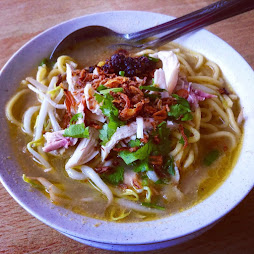Mee Rebus and Mee Siam
Literally "boiled noodles", a delicious dish that can be found in many hawker centres, mee rebus is a popular and tasty Malay culinary creation. It is a simple yet satisfyingly filling dish of the common yellow Hokkien noodles and sweet-spicy flavourful gravy garnished with boiled egg, beansprouts, Chinese celery, green chilli, cubed fried tofu and sprinkled with fried shallot and topped with fresh calamansi. A squeeze of small fresh greenish calamansi lime gives the dish citrusy note, adds tang and brightens up the dish. In Malay calamansi is called limau kasturi.
Mee is a Hokkien word for 'noodles' and rebus is a Malay word for 'boiled', thus we can see how different cultures complement and influence each other.The most crucial element in mee rebus is the gravy, which the soul of this deceptively simple dish. Traditionally, it is made from a stock base of dried shrimp, tau cheo (fermented soy bean), fresh herbs and spices, which is thickened with mashed sweet potato, thus giving rise to umami flavour. The salted fermented soybean create the earthy and rich umami flavour and is used in seasoning in many south-east asian cookings.
However, different vendors have put their own unique spin on the traditional recipe. Some hawker centre stalls are getting creative with menus such as mee rebus tarik and mee rebus with satay for the added protein, and satay is a favourite with many as well. Mee rebus with satay may have peanut sauce as well. So there is teh-tarik and there is also mee rebus tarik.
Mee Siam is a popular local dish amongst the Peranakan (Straits Chinese) and the Malays and are enjoyed in both in Singapore and Malaysia. It consists of thin mee or rice vermicelli noodles, instead of the thicker yellow noodles, and served in a sweet, sour, and slightly spicy gravy, often garnished with ingredients like hard-boiled eggs, fried tofu, and chives. A tangy, slightly spicy broth is made with tamarind, dried shrimp, shallots, garlic, chili, and fermented bean paste known locally as taucheo.
The garnishes in mee siam can include bean sprouts, chives, lime wedges, and chilli paste or sambal for spiciness and typically served with a squeeze of calamansi lime for extra tanginess and fresh herbs for aroma just like mee rebus. The traditional mee siam is the one with gravy like a noodle soup, though is also the dry version that is tossed in a thicker, flavourful sauce without the soupy gravy. The dry mee siam may resemble a little to the fried bee hoon, another common Singapore dish. For added protein, some may add shrimp or prawns apart from the usual hard-boiled egg.
The hard-boiled egg and the lime are common features in both mee rebus and mee siam. Just like mee rebus, you can find mee siam at many hawkers centres all over Singapore. While mee rebus is largely sold by Malay hawkers, mee siam can be found in both Malay and Chinese stalls. A plate typically range from $4 to $7, the pricier one for a plate of mee rebus with satay sticks.
Mee is a Hokkien word for 'noodles' and rebus is a Malay word for 'boiled', thus we can see how different cultures complement and influence each other.The most crucial element in mee rebus is the gravy, which the soul of this deceptively simple dish. Traditionally, it is made from a stock base of dried shrimp, tau cheo (fermented soy bean), fresh herbs and spices, which is thickened with mashed sweet potato, thus giving rise to umami flavour. The salted fermented soybean create the earthy and rich umami flavour and is used in seasoning in many south-east asian cookings.
 |
| Mee rebus with shallot, fresh chilli and calamansi |
Mee Siam is a popular local dish amongst the Peranakan (Straits Chinese) and the Malays and are enjoyed in both in Singapore and Malaysia. It consists of thin mee or rice vermicelli noodles, instead of the thicker yellow noodles, and served in a sweet, sour, and slightly spicy gravy, often garnished with ingredients like hard-boiled eggs, fried tofu, and chives. A tangy, slightly spicy broth is made with tamarind, dried shrimp, shallots, garlic, chili, and fermented bean paste known locally as taucheo.
 |
| Mee Siam with cut limau kasturi |
The hard-boiled egg and the lime are common features in both mee rebus and mee siam. Just like mee rebus, you can find mee siam at many hawkers centres all over Singapore. While mee rebus is largely sold by Malay hawkers, mee siam can be found in both Malay and Chinese stalls. A plate typically range from $4 to $7, the pricier one for a plate of mee rebus with satay sticks.



Comments
Post a Comment